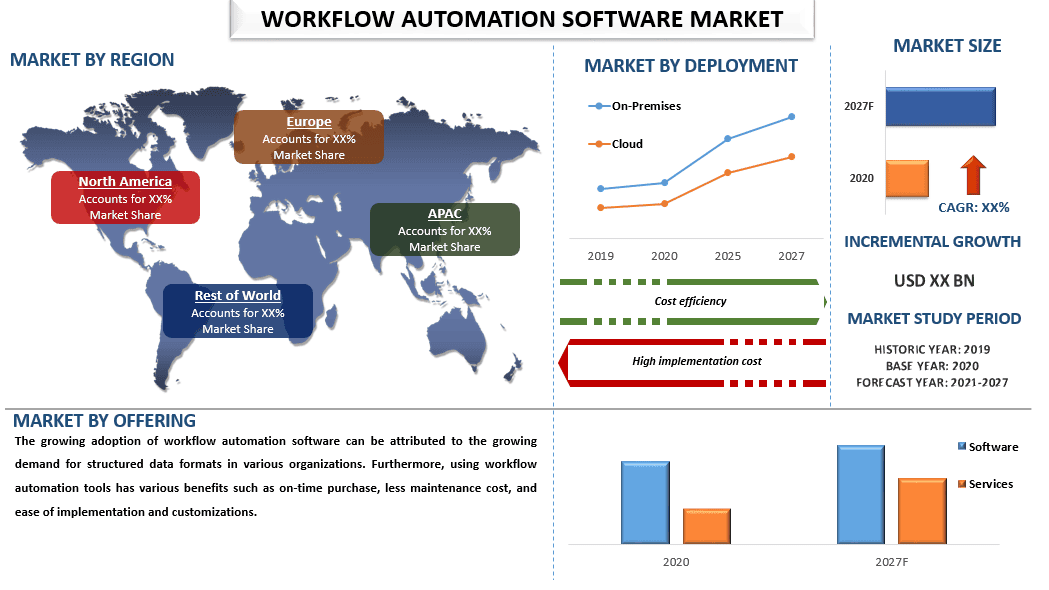- Home
- About Us
- Industry
- Services
- Reading
- Contact Us
Workflow Automation Market: Current Analysis and Forecast (2021-2027)
Emphases on, Offering (Enterprise Risk Management, Financial Risk Management, Application Risk Management); Process (Automation Solutions, Decision Support and Management, And Interaction Solution); Deployment (On-Premises, and Cloud); End-User (Manufacturing, Logistics, Healthcare, And Pharmaceuticals, Retail, Telecom, Banking, and Others)

The Global Workflow Automation Market is expected to grow at a CAGR of 17% during the forecast period 2021-2027.
Workflow automation refers to the process of automating a set of manual processes or tasks based on a set of pre-defined rules or conditions. It helps you reduce the use of resources and time, more importantly, the chances of human-made errors. As a result, it improves a business’s overall efficiency, audibility, and accountability. The growing adoption of workflow automation is surging due to the increasing complexities involved in workforce management. Furthermore, workflow automation provides several benefits to enterprises including – streamlining communication, creating accountability, reducing costs and error, creating more workplace efficiency, empowering employees to manage their own time, improving management, and providing real-time reports. Additionally growing use of workflow automation software in hospitals and medical centers for managing repetitive documentation, administrative & medical staff management as well as easy access to the patient’s administrative and clinical data in all the departments.
Insights Presented in the Report
“Amongst offering, the software category accounted for the majority share in the market in 2020”
Based on offering, the market is segmented into software and services. The software segment is expected to achieve considerable prominence during the forecast period. The growing adoption of workflow automation software can be attributed to the growing demand for structured data formats in various organizations. Furthermore, using workflow automation tools has various benefits such as on-time purchase, less maintenance cost, and ease of implementation and customizations. Moreover, organizations around the world are investing heavily in the innovation and research and development of workflow automation software.
“Amongst process, the automation solution segment is expected to witness the highest CAGR during the forecast period”
Based on process the market is segmented into automation solutions, decision support and management solution, and interaction solution. During the forecast period, the automation solutions are expected to achieve a significant CAGR, owing to the high degree of flexibility and scalability of the automated solutions. Furthermore, the growing demand for real-time data analysis across geographies and increasing adoption of the latest technology across various end-use industries to improve performance are expected to drive the workflow automation market.
“Amongst deployment, the cloud segment is expected to witness the highest CAGR during the forecast period”
Based on deployment the market is segmented into on-premises and cloud. During the forecast period, the cloud-based segment is expected to hold the majority of the market owing to the ease of implementation of the cloud-based solutions. Moreover, moving to the cloud saves the upfront cost of purchasing, managing, and upgrading IT systems. Thus, using the cloud model converts capital expenditure to operational expenditure. The cloud provides accessibility from anywhere, data on the cloud can be accessed from anywhere and has zero to very less maintenance costs.
“Amongst end-user, the retail industry is expected to witness the highest CAGR during the forecast period”
Based on end-user, the market is segmented into manufacturing, logistics, healthcare and pharmaceuticals, retail, telecom & Pharmaceuticals, banking, and others. The retail industry is expected to achieve a significant CAGR during the forecast period. Workflow automation enhances the customer experience by capturing and analyzing patterns, identifying, predicting, and providing on-demand services. These factors are driving the growth of workflow automation in the retail industry. Workflow automation gives retailers access to all their business matters for a timely response, further driving their adoption in the workflow automation industry.
“North America to witness significant growth during the forecast period”
North America to witness significant growth during the forecast period, the countries such as the US, and Canada are implementing workflow automation in different verticals such as banking, telecom, retail, and others to manage business processes. Furthermore, the rising focus on digital transformation initiatives, growing adoption of cloud technology, and increasing penetration of process management & automation solutions in this region are the primary factors that are boosting the market growth.
Reasons to buy this report:
- The study includes market sizing and forecasting analysis validated by authenticated key industry experts.
- The report presents a quick review of overall industry performance at one glance.
- The report covers an in-depth analysis of prominent industry peers with a primary focus on key business financials, product portfolios, expansion strategies, and recent developments.
- Detailed examination of drivers, restraints, key trends, and opportunities prevailing in the industry.
- The study comprehensively covers the market across different segments.
- Deep dive regional level analysis of the industry.
Customization Options:
The global workflow automation market can further be customized as per the requirement or any other market segment. Besides this, UMI understands that you may have your own business needs, hence feel free to connect with us to get a report that completely suits your requirements.
Table of Content
Research Methodology for The Global Workflow Automation Market Analysis (2021-2027)
Analyzing the historical market, estimating the current market, and forecasting the future market of the global workflow automation market were the three major steps undertaken to create and analyze the adoption of workflow automation in major regions globally. Exhaustive secondary research was conducted to collect the historical market numbers and estimate the current market size. Secondly, to validate these insights, numerous findings and assumptions were taken into consideration. Moreover, exhaustive primary interviews were also conducted, with industry experts across the value chain of the global workflow automation market. Post assumption and validation of market numbers through primary interviews, we employed a top-down/bottom-up approach to forecasting the complete market size. Thereafter, market breakdown and data triangulation methods were adopted to estimate and analyze the market size of segments and sub-segments of the industry pertains to. Detailed methodology is explained below:
Analysis of Historical Market Size
Step 1: In-Depth Study of Secondary Sources:
Detail secondary study was conducted to obtain the historical market size of the workflow automation market through company internal sources such as annual reports & financial statements, performance presentations, press releases, etc., and external sources including journals, news & articles, government publications, competitor publications, sector reports, third-party database, and other credible publications.
Step 2: Market Segmentation:
After obtaining the historical market size of the workflow automation market, we conducted a detailed secondary analysis to gather historical market insights and share for different segments & sub-segments for major regions. Major segments are included in the report as offering, process, deployment, and end-user industry. Further country-level analyses were conducted to evaluate the overall adoption of testing models in that region.
Step 3: Factor Analysis:
After acquiring the historical market size of different segments and sub-segments, we conducted a detailed factor analysis to estimate the current market size of the workflow automation market. Further, we conducted factor analysis using dependent and independent variables such as offering, process, deployment, and end-user industry of workflow automation. A thorough analysis was conducted for demand and supply-side scenarios considering top partnerships, mergers and acquisitions, business expansion, and product launches in the workflow automation market sector across the globe.
Current Market Size Estimate & Forecast
Current Market Sizing: Based on actionable insights from the above 3 steps, we arrived at the current market size, key players in the global workflow automation market, and market shares of the segments. All the required percentage shares split, and market breakdowns were determined using the above-mentioned secondary approach and were verified through primary interviews.
Estimation & Forecasting: For market estimation and forecast, weights were assigned to different factors including drivers & trends, restraints, and opportunities available for the stakeholders. After analyzing these factors, relevant forecasting techniques i.e., top-down/bottom-up approach were applied to arrive at the market forecast about 2027 for different segments and sub-segments across the major markets globally. The research methodology adopted to estimate the market size encompasses:
- The industry’s market size, in terms of revenue (USD) and the adoption rate of the workflow automation market across the major markets domestically
- All percentage shares, splits, and breakdowns of market segments and sub-segments
- Key players in the global workflow automation market in terms of offering, process, deployment, and end-user industry. Also, the growth strategies adopted by these players to compete in the fast-growing market
Market Size and Share Validation
Primary Research: In-depth interviews were conducted with the Key Opinion Leaders (KOLs) including Top Level Executives (CXO/VPs, Sales Head, Marketing Head, Operational Head, and Regional Head, Country Head, etc.) across major regions. Primary research findings were then summarized, and statistical analysis was performed to prove the stated hypothesis. Inputs from primary research were consolidated with secondary findings, hence turning information into actionable insights.
Split of Primary Participants in Different Regions

Market Engineering
Data triangulation technique was employed to complete the overall market estimation and to arrive at precise statistical numbers of each segment and sub-segment of the global workflow automation market. Data was split into several segments & sub-segments post studying various parameters and trends in the areas of offering and technique in the global workflow automation market.
The main objective of the global workflow automation market study
The current & future market trends of the global workflow automation market were pinpointed in the study. Investors can gain strategic insights to base their discretion for investments on the qualitative and quantitative analysis performed in the study. Current and future market trends determined the overall attractiveness of the market at a regional level, providing a platform for the industrial participant to exploit the untapped market to benefit from a first-mover advantage. Other quantitative goals of the studies include:
- Analyze the current and forecast market size of the workflow automation market in terms of value (USD). Also, analyze the current and forecast market size of different segments and sub-segments
- Segments in the study include areas of offering, process, deployment, and end-user industry.
- Define and analysis of the regulatory framework for the workflow automation market industry.
- Analyze the value chain involved with the presence of various intermediaries, along with analyzing customer and competitor behaviors of the industry.
- Analyze the current and forecast market size of the workflow automation market for the major region.
- Major countries of regions studied in the report include Asia Pacific, Europe, North America, and the Rest of the world.
- Company profiles of the workflow automation market and the growth strategies adopted by the market players to sustain in the fast-growing market
- Deep dive regional level analysis of the industry
Related Reports
Customers who bought this item also bought










